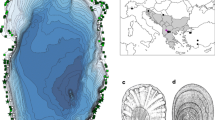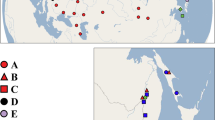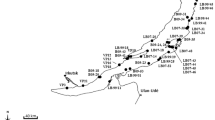Abstract
Ancient sister lakes are considered to be ancient lakes lying in close geographic proximity, sharing a related origin and significant time of co-existence, usually having hydrological connection as well as a balanced degree of faunal overlap and distinctness. A paradigm for studying sister lake relationships are the ancient lakes Ohrid and Prespa in the Balkans, which are characterized by high degrees of endemicity. Three general patterns of endemic species can be distinguished for these lakes: (1) taxa that are endemic to either lake, with no close relatives in the respective sister lake, (2) closely related but distinct endemic taxa in both lakes (sister species) and (3) shared endemic taxa occurring in both lakes. In the present paper, two endemic freshwater pulmonate gastropod species, Radix relicta (Lake Ohrid) and R. pinteri (Lake Prespa), are used to study the evolution of presumed sister species based on biogeographical and comparative DNA data from world-wide Radix taxa. Phylogenetic, phylogeographical and parametric bootstrap analyses all suggest a sister group relationship of R. relicta and R. pinteri (pattern 2 of endemic diversity). Sister to these two taxa is the widespread R. ampla, which does not occur in the vicinity of lakes Ohrid and Prespa. The southern feeder spring complexes of Lake Ohrid are inhabited by another lineage (Radix sp. 1), which resembles Radix relicta in morphology/anatomy. For Lake Prespa, the widespread R. auricularia was reported in addition to the endemic R. pinteri. Comparative phylogenetic data favour a western Adriatic zoogeographical affinity of lakes Ohrid and Prespa over an Aegean-Anatolian faunal connection. The status of lakes Ohrid and Prespa as sister lakes is evaluated in the light of current knowledge on gastropod speciation and endemism in these hotspots of biodiversity.




Similar content being viewed by others
References
Albrecht, C., R. Schultheiß, T. Kevrekidis, B. Streit & T. Wilke, 2007. Invaders or endemics? Molecular phylogenetics, biogeography and systematics of Dreissena in the Balkans. Freshwater Biology 52: 1525–1536.
Albrecht, C., S. Trajanovski, K. Kuhn, B. Streit & T. Wilke, 2006. Rapid evolution of an ancient lake species flock: freshwater limpets (Gastropoda: Ancylidae) in the Balkan lake Ohrid. Organisms Diversity & Evolution 6: 294–307.
Albrecht, C. & T. Wilke, 2008. Lake Ohrid: biodiversity and evolution. Hydrobiologia. doi:10.1007/s10750-008-9558-y.
Albrecht, C., T. Wilke, K. Kuhn & B. Streit, 2004. Convergent evolution of shell shape in freshwater limpets. The African genus Burnupia. Zoological Journal of the Linnean Society 140: 577–588.
Amataj, S., T. Anovski, R. Benischke, R. Eftimi, L. L. Gourcy, L. Kola, I. Leontiadis, E. Micevski, A. Stamos & J. Zoto, 2007. Tracer methods used to verify the hypothesis of Cvijic about the underground connection between Prespa and Ohrid Lake. Environmental Geology 51: 749–753.
Bargues, M. D. & S. Mas-Coma, 1997. Phylogenetic analysis of lymnaeid snails based on 18S rDNA sequences. Molecular Biology and Evolution 14: 569–577.
Bargues, M. D., M. Vigo, P. Horak, J. Dvorak, R. A. Patzner, J. P. Pointier, M. Jackiewicz, C. Meier-Brook & S. Mas-Coma, 2001. European Lymnaeidae (Mollusca: Gastropoda), intermediate hosts of trematodiases, based on nuclear ribosomal DNA ITS-2 sequences. Infection. Genetics and Evolution 1: 85–107.
Burch, J. B. & S. Hadžišče, 1974. Immunological relationships of two species of Lymnaeidae (Mollusca: Basommatophora) from Macedonia, Yugoslavia. Malacological Review 7: 25–32.
Clement, M., D. Posada & K. Crandall, 2000. TCS. A computer program to estimate gene genealogies. Molecular Ecology 9: 1657–1660.
Coulter, G. W. (ed.), 1991. Lake Tanganyika and Its Life. Oxford University Press, New York.
Cowie, R. H., 2001. Invertebrate invasions on Pacific Islands and the replacement of unique native faunas: a synthesis of the land and freshwater snails. Biological Invasions 3: 119–136.
Cvijic, J., 1911. Fundamentals of geography and geology of Macedonia and Old Serbia. Book III, Serbian Academy of Sciences, Special Edition, Beograd (in Serbian).
Denèfle, M., A.-M. Lézine, E. Fouache & J.-J. Dufaure, 2000. A 12, 000-year pollen record from Lake Maliq, Albania. Quaternary Research 54: 423–432.
Dumurdzanov, N., T. Serofimovski & B. C. Burchfield, 2004. Evolution of the Neogene-Pleistocene Basins of Macedonia. Geological Society of America Digital Map and Chart Series 1: 1–20.
Falkner, G., 1990. Binnenmollusken. In Fechter, R. & G. Falkner (eds), Weichtiere. Europäische Meeres- und Binnenmollusken. Mosaik Verlag, München.
Felsenstein, J., 1985. Confidence limits on phylogenies: an approach using the bootstrap. Evolution 39: 783–791.
Folmer, O., M. Black, W. Hoeh, R. Lutz & R. Vrijenhoek, 1994. DNA primers for amplification of mitochondrial cytochrome c oxidase subunit I from diverse metazoan invertebrates. Molecular Marine Biology & Biotechnology 3: 294–299.
Glöer, P., C. Albrecht & T. Wilke, 2007. Enigmatic distribution pattern of the Bithyniidae in the Balkan Region (Gastropoda: Rissooidea). Mollusca 25: 13–22.
Glöer, P. & I. Sîrbu, 2006. Freshwater molluscs species, new fort he Romanian fauna. Heldia 6: 207–216.
Gorthner, A., 1994. What is an ancient lake? Archiv für Hydrobiologie 44: 97–100.
Gorthner, A. & C. Meier-Brook, 1985. The Steinheim Basin as a paleo-ancient lake. In Bayer, U. & A. Seilacher (eds), Sedimentary and Evolutionary Cycles. Springer, Berlin, Heidelberg, New York, Tokyo: 322–334.
Hadžišče, S., 1956. III. Beitrag zur Kenntnis der Gastropodenfauna des Ohridsees. Beschreibung der bis jetzt unbekannten Schnecken und Beispiele der Speciation bei den Gastropoden des Ohridsees. Recueil des Traveaux, Station Hydrobiologique. Ohrid 4: 57–107.
Hall, T. A., 1999. BioEdit. A user-friendly biological sequence alignment editor and analysis program for Windows 95/98/NT. Nucleic Acids Symposium Series 41: 95–98.
Hauswald, A.-K., C. Albrecht & T. Wilke, 2008. Testing two contrasting evolutionary patterns in ancient lakes: species flock vs. species scatter in valvatid gastropods of Lake Ohrid. Hydrobiologia. doi:10.1007/s10750-008-9556-0.
Hillis, D. M., B. K. Mable & C. Moritz, 1996. Applications of molecular systematics. In Hillis, D. M. C. Moritz & B. K. Mable (eds), Molecular Systematics, 2 edn. Sinauer Associates Inc., Sunderland, MA: 515–543.
Hubendick, B., 1951. Recent Lymnaeidae. Their variation, morphology, taxonomy, nomenclature, and distribution. Kunglinska Svenska Vetenskapsacedemiens Handlingar, Ser. 4 3: 1–223.
Hubendick, B. & P. Radoman, 1959. Studies on the Gyraulus species of Lake Ochrid. Morphology. Archiv för Zoologi 12: 223–243.
Huelsenbeck, J. P. & K. A. Crandall, 1997. Phylogeny estimation and hypothesis testing using maximum likelihood. Annual Review of Ecology and Systematics 28: 437–466.
Huelsenbeck, J. P. & F. Ronquist, 2001. MRBAYES. Bayesian inference of phylogeny. Bioinformatics 17: 754–755.
Jackiewicz, M., 1998. European species of the family Lymnaeidae (Gastropoda: Pulmonata: Basommatophora). Genus 9: 1–93.
Karaman, M., 1971. Zoogeographische Verhältnisse des Prespa- und Ohridsees. Izdanija 4: 1–21.
Kaiser, P., 1959. Über die Atmung von Radix relicta Pol. aus dem Ohrid-See. Recueil des travaux Ohrid 35: 1–5.
Kumar, S., K. Tamura & M. Nei, 2004. MEGA3: integrated software for molecular evolutionary genetics analysis and sequence. Alignment Briefings in Bioinformatics 5: 150–163.
Martens, K., 1997. Speciation in ancient lakes (review). Trends in Ecology and Evolution 12: 177–182.
Matzinger, A., M. Jordanoski, E. Veljanoska-Sarafiloska, M. Sturm, B. Müller & A. Wüest, 2006. Is Lake Prespa jeopardizing the ecosystem of ancient Lake Ohrid? Hydrobiologia 553: 89–109.
Matzinger, A., M. Schmid, E. Veljanoska-Sarafiloska, S. Patceva, D. Guseska, B. Wagner, B. Müller, M. Sturm & A. Wüest, 2007. Eutrophication of ancient Lake Ohrid: global warming amplifies detrimental effects of increased nutrient inputs. Limnology and Oceanography 52: 338–353.
Pfenninger, M., M. Cordellier & B. Streit, 2006. Comparing the efficacy of morphologic and DNA-based taxonomy in the freshwater gastropod genus Radix (Basommatophora, Pulmonata). BMC Evolutionary Biology 6: 100.
Polinski, W., 1932. Die reliktäre Gastropodenfauna des Ohrida-Sees. Zoologische Jahrbücher Abteilung Systematik 62: 611–666.
Posada, D. & K. A. Crandall, 1998. Modeltest: testing the model of DNA substitution. Bioinformatics 14: 817–818.
Posada, D. & K. A. Crandall, 2001. Selecting the best-fit model of nucleotide substitution. Systematic Biology 50: 580–601.
Radoman, P., 1985. Hydrobioidea, a superfamily Prosobranchia (Gastropoda), II. Origin, zoogeography, evolution in the Balkans and Asia Minor. Monographs Institute of Zoology 1, Beograd.
Rambaut, A. & N. C. Grassly, 1997. Seq-Gen: an application for the Monte Carlo simulation of DNA sequence evolution along phylogenetic trees, Version 1.1. Computer Applications in the Biosciences 13: 235–238.
Remigio, E. A., 2002. Molecular phylogenetic relationships in the aquatic snail genus Lymnaea, the intermediate host of the causative agent of fascioliasis: insights from broader taxon sampling. Parasitology Research 88: 687–696.
Remigio, E. A. & D. Blair, 1997. Molecular systematics of the freshwater snail family Lymnaeidae (Pulmonata: Basommatophora) utilising mitochondrial ribosomal DNA sequences. Journal of Molluscan Studies 63: 173–185.
von Rintelen, T. & M. Glaubrecht, 2005. Anatomy of an adaptive radiation: a unique reproductive strategy in the endemic freshwater gastropod Tylomelania (Cerithioidea: Pachychilidae) on Sulawesi, Indonesia, and its biogeographic implications. Biological Journal of the Linnean Society 85: 513–542.
von Rintelen, T. & M. Glaubrecht, 2006. Rapid evolution of sessility in an endemic species flock of the freshwater bivalve Corbicula from ancient lakes on Sulawesi, Indonesia. Biology Letters 2: 73–77.
Schultheiß, R., C. Albrecht, U. Bößneck & T. Wilke, 2008. The neglected side of speciation in ancient lakes: phylogeography of an inconspicuous mollusk taxon in lakes Ohrid and Prespa. Hydrobiologia. doi:10.1007/s10750-008-9553-3.
Schütt, H., 1974. Zwei neue reliktäre Süßwassermollusken der Dinariden. Annalen des Naturhistorischen Museums in Wien 78: 473–480.
Schütt, H., 2006. Die Entrollung des Gewindes bei Lymnaeiden (Eine Literaturübersicht). Mitteilungen der deutschen malakozoologischen Gesellschaft 75: 5–7.
Spirkovski, Z., O. Avramovski & A. Kodzoman, 2001. Watershed management in the Lake Ohrid region of Albania and Macedonia. Lakes & Reservoirs: Research and Management 6: 237–242.
Stanković, S., 1960. The Balkan Lake Ohrid and Its Living World. Monographiae Biologicae Vol. IX, Uitgeverij Dr. W. Junk, Den Haag.
Sturany, R., 1894. Zur Molluskenfauna der europäischen Türkei. Annalen des kaiserlich königlichen Naturhistorischen Hofmuseums 9: 369–394.
Swofford, D. L., 2002. PAUP. Phylogenetic analysis using parsimony (and other methods). Version 410b. Sinauer Associates, Sunderland, Mass.
Wilke, T., C. Albrecht, V. V. Anistratenko, S. K. Sahin & Z. Yildirim, 2007. Testing biogeographical hypotheses in space and time: faunal relationships of the putative ancient lake Egirdir in Asia Minor. Journal of Biogeography 34: 1807–1821.
Wilke, T., G. M. Davis, Q. Dongchuan & R. C. Spear, 2006. Extreme mitochondrial sequence diversity in the intermediate schistosomiasis host Oncomelania hupensis robertsoni: another case of ancestral polymorphism? Malacologia 48: 143–157.
Zacharias, I., I. Bertachas, N. Skoulikidis & T. Koussouris, 2002. Greek lakes: limnological overview. Lakes & Reservoirs: Research and Management 7: 55–62.
Acknowledgements
We are very grateful to the colleagues of the Hydrobiological Institute Ohrid for their immense support. S. Trajanovski, B. Budzakoska and S. Trajanovska provided valuable information and took part in some field trips. D. Georgiev and B. Streit generously supported our field work. T. Kevrekidis and A. Mogias perfectly organized field work in Greece. Z. Yildirim and S. Koşal Şahin sent material from Turkey, whereas Z. Fehér provided Albanian material, M. Zettler material from Corsica, R. Patzner from Wallersee, and V. Pešić from Montenegro and Serbia. The comments of two anonymous reviewers enhanced an earlier version of the manuscript. We wish to express our deepest gratitude to all of them.
Author information
Authors and Affiliations
Corresponding author
Additional information
Guest editors: T. Wilke, R. Väinölä & F. Riedel
Patterns and Processes of Speciation in Ancient Lakes: Proceedings of the Fourth Symposium on Speciation in Ancient Lakes, Berlin, Germany, September 4–8, 2006
Electronic supplementary material
Rights and permissions
About this article
Cite this article
Albrecht, C., Wolff, C., Glöer, P. et al. Concurrent evolution of ancient sister lakes and sister species: the freshwater gastropod genus Radix in lakes Ohrid and Prespa. Hydrobiologia 615, 157–167 (2008). https://doi.org/10.1007/s10750-008-9555-1
Published:
Issue Date:
DOI: https://doi.org/10.1007/s10750-008-9555-1




